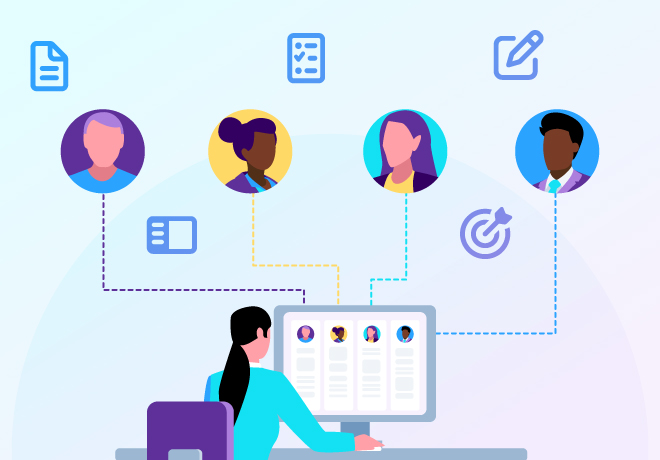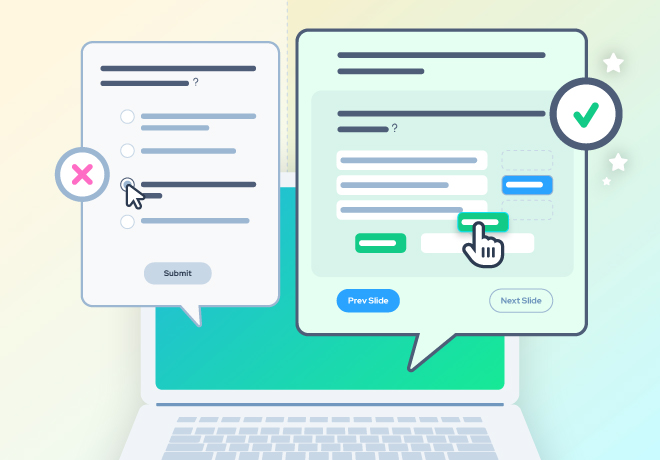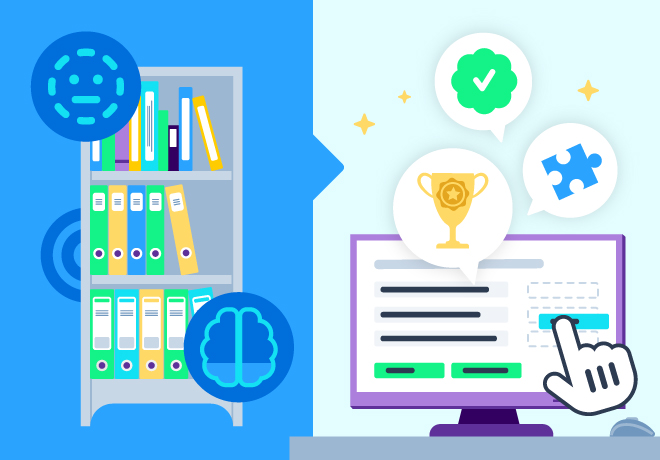
When to consider using an LXP as the learning platform of choice for your company

Related articles
Get valuable eLearning insights to your inbox.
Listen to Neovation’s Demystifying eLearning podcast generated with NotebookLM!
Listen to our podcast on your favorite platform!
Do you remember the first time you used Netflix?
The excitement you felt accessing a whole library of content all at once. The power you felt choosing a movie you actually wanted to see. The comfort and convenience of having personalized content recommendations at your fingertips instead of those long walks to Blockbuster (whoops – did I just give away my age?)
Now imagine taking the same approach to your organization’s eLearning program.
Cue the Learning Experience Platform (LXP).
What is an LXP (Learning Experience Platform)?
An LXP (or Learning Experience Platform) is user-centered software designed much like our favorite streaming service. It features a robust library that can accommodate both company courses and a wide array of 3rd-party content (think blog articles, PDF documents, videos, and podcasts).
With an LXP, your employees will always have access to the kind of training content that interests them. Typically, learners can interact with their training in the way that best suits them – long-form courses, video courses, interactive content, and quizzes/assessments. They can even build a learning path to reach a training goal they want to achieve. Then, with a little help (okay, a lot of help) from AI technology (artificial intelligence), they’re provided with personalized recommendations that match their unique learning needs.
Sounds incredible, I know. Your employees can choose what they learn, when they learn, and how they learn.
The goal of an LXP is to engage your employees by deploying training as part of a highly customizable and interactive user experience. LXPs can also include social components, like badges, leaderboards, comment sections, and user profiles, to foster team collaboration and participation.
Now here’s where things get really interesting.
While the LXP represents the latest evolution of training technology, its long-time precursor, the Learning Management System (LMS), continues to maintain a strong presence and reputation in the corporate workplace.
Fun Fact: The first Learning Management System was developed in 1924, meaning modern LMSs are rooted in almost 100 years of history.
What is the difference between an LXP and an LMS?
The fundamental difference between the two platforms lies in who’s in the driver’s seat.
An LMS is designed for companies to deliver corporate learning content to their employees. LMS software is geared towards catalog management for employee onboarding, development, and compliance training purposes and is highly useful for training administrators and managers to organize, assign, and track important training content. Typically, the LMS administrator has complete control over the training content and decides who starts which learning plan. Then, it’s up to the learner to follow a specific path through the content.
An LXP, on the other hand, requires a lot more user involvement. Because an LXP is an experience-driven platform, its content library focuses less on mandatory training and more on the user's needs. There is no specific path or plan a learner needs to take inside the learning portal. Instead, employees can navigate a variety of media content based on their interests. Ultimately, an LXP allows your learners to tailor their experiences, giving you meaningful clues about their career interests skill development insights.

On paper, the LXP seems like it could tick all your organization’s training check boxes. It’s autonomous, it’s easy to use, and it’s the “training system of the future.” Who wouldn’t want that?
But suddenly… that little voice in your head says: Is the LXP really the best learning platform for my business?
If you’ve checked out any of my colleague Susan’s articles in our Learning Hub, then you already know her favorite answer to this kind of question…
“It depends!”
Spotify’s Global Head of Learning & Development, Johanna Bolin Tingvall, said, “We're getting older as human beings, and the lifetime of companies is getting shorter, which puts a responsibility on all of us to upskill and reskill more often.” But part of upskilling and reskilling is identifying your business goals and determining which educational tool will most effectively achieve them. In some cases, an LXP may align directly with your organization’s learning objectives. But in other situations, you may find that a Learning Management System (LMS) is a better fit.
When is an LMS better suited for delivering your online training program?
To help illustrate situations where an LMS may be better suited to deliver training over an LXP (and vice versa), we’ll walk through a couple of scenarios any training manager will surely relate to.
Take this one, for instance:
An LMS would be better suited for this workplace because its top-down, management-directed approach allows the training administrator to ensure that every employee gets the same learning material, takes their assessment, and completes their training by the assigned due date.
When is an LXP better suited for delivering your online training program?
By now, I probably don’t have to tell you I love a good scenario. So, here’s another one for you:
You’re heading for your second cup of coffee, and you overhear one of your employees say: “I really wish I could develop my writing skills.” This quarter you’re on a mission to provide more personal growth and skill development opportunities. (After all, 54% of employees say that training and developing new skills is essential to keep up with changes in the workplace.) So, which training platform is better in this case?
I’ll take the LXP for $200, Alex.
![Three charts in a horizontal row; one is a pie chart (left-most side) and the other two are similar-looking bar charts (both to the right of the pie). The pie chart has 54% shaded in and beneath there is text that says, "[54%] of employees say that training and developing new skills is essential to keep up with changes in the workplace." The data for the first bar chart to the immediate right of the pie chart is titled "Employees who have taken a class or gotten extra training in the past 12 months...". It has two columns, from left-to-right: "To learn, maintain, or or improve job skills," 45%; "For a license of certification," 30%. The other bar chart, to the right of the previous, is labelled, "Among the employees who took a class or got extra training did so in order to…". It has 4 columns, from left to right: "Meet employer requirements," 52%; "Earn more money," 34%, "Get a new job," 26%; "Be promoted," 25%. (Source: https://www.pewresearch.org/social-trends/2016/10/06/4-skills-and-training-needed-to-compete-in-todays-economy/)](https://cdn.prod.website-files.com/640f4f30f0ecd3685f6e970e/640f4f30f0ecd3f2fa6e9ff3_Employee-training.png)
While an LMS is definitely well-suited for a more structured learning environment, an AI-driven LXP will recommend relevant blog posts, articles, documents, and videos to help your employees develop the skills they’re most interested in learning organically or at their own pace.
Okay, so the choice between the LMS and LXP is pretty clear in these situations. But we all know that real life is a lot more nuanced than that. So what happens when you want to give your employees the exciting and convenient user experience of an LXP but also make sure they actually complete their mandatory training on time? How do you decide between one or the other?
The technology blur between an LMS and an LXP
The good news is neither the LXP nor LMS platform is exclusive to either form of training delivery. In fact, due to competitiveness in the learning and development software industry, you might find a learning system that is a blend of both worlds.
Take the SmarterU LMS, for instance. It follows your traditional LMS's architectural structure – management-administered content and activity tracking. But it also includes some LXP elements like mobile apps for on-the-go training, gamification elements, and customizable learning plans.
The overlap of features provides you with more flexibility and freedom when it comes to choosing your learning platform – which means employees can enjoy the training components they really want without compromising your training priorities. Talk about a win-win!
Now let’s just say, after reading this article, you’re thinking, “I’m 100% set on an LXP.”
What are must-have LXP features you should look for?
In this case, you don’t necessarily have to worry about compromising your training priorities since your employees’ experiences will be self-directed. But a few features are a must to ensure your team gets the most out of your Learning Experience Platform. These include:

An intuitive user interface (UI) and user experience (UX)
Your employees will spend a lot of time interacting with your LXP’s content library. When selecting LXP software, pay special attention to how familiar the user interface feels. Having your LXP’s user experience mimic other common software your learners already use (i.e., Netflix, Duolingo, etc.) can go a long way in helping with widespread adoption. And, of course, it should be visually appealing and easy for your less tech-savvy employees to navigate.

User-generated content (UGC)
Creating all your training content from scratch can be expensive, time-consuming, and just plain exhausting. But UGC provides easy access to topics your employees actually care about. It opens your workforce up to a world of new learning opportunities and can help form the bridge for increased mentorship and peer-to-peer learning.

Easy content creation and curation
The premise of an LXP is that it becomes the foundation of your eLearning ecosystem that is constantly expanding. That means it has to be simple and easy for content to be created and populated within the LXP system. At the very minimum, your LXP should:
- Allow users to create and share a wide variety of content on any device
- Easily integrate with 3rd-party content tools
- Save content for your employees to come back to later
- Include high-performing search tools

Enhanced data insights and reporting
What’s the easiest way to show visible ROI (Return On Investment)? Two words: Learning Analytics. When choosing your LXP, make sure it has powerful reporting functionality that gives insight into learner behavior, content and platform performance, and learner engagement. The learning analytics data your LXP provides will not only help inform and improve your training strategies, but it will come in handy when your C-suite team asks for measurable results!
What other nice-to-have LXP features should you consider while shopping?
I mean, since we’re already “shopping,” here are some additional features you may also want your LXP to have.
For your learners
- A mobile app: for access to learning modules wherever and whenever your employees want to learn
- Community building elements: for users to follow, connect, and engage with like-minded people
- Social curation of training content: gives learners the opportunity to share, like or upvote, and comment on content
For your training administrators
- Automation tools: Auto-curation and auto-reporting frees up your time to focus on more important stuff
- Multi-user collaboration: More hands make less work! Get your entire L&D team developing courses for your organization, with an eLearning authoring tool that offers advanced features like versioning and supports multiple users (similar to Google Docs)
- Skill building that connects to learning: Focus your training on what you really want – to build your employees skills. Look for an LXP that allows you to connect your training to a skills taxonomy that provides insight on the skill gaps your learners are closing
How you can use an LXP across some of the most common learning use cases
We’ve already looked at how an LXP can positively affect an employee’s personal growth. But here’s how you can apply your LXP software to help your organization with some common training scenarios.
Using your LXP for employee onboarding
A Glassdoor report shows that organizations with a strong onboarding process improve new hire retention by 82% and productivity by over 70%. Thanks to its curated library and self-directed structure, an LXP allows new employees to go through the orientation and training material at their own pace. Help your new hires by reducing stress, encouraging more active participation, and giving them a clearer understanding of their role.

Using your LXP for upskilling and reskilling
To effectively develop your employees' skills (both new and existing), there are questions you first need to address. They are:
- Who needs training, and in which areas?
- Where is the organizational skills gap?
- What skills do we need to execute our strategy?
An LXP can help answer some of these questions. Artificial intelligence (AI) and machine learning (ML) capabilities allow this platform to categorize and recommend personalized content to the user.
Using your LXP for retaining and sharing employee knowledge
An LXP encourages collaboration and knowledge-sharing by enabling employees to publish, share, and discuss learning content they find helpful. Its architecture also supports more data-driven learning, which you can better leverage more informed policy-making and visible ROI to your C-Suite and leadership team.
With the LXPs flexibility and easy adaptability into existing corporate structures, some have even dubbed the LXP as “the more advanced, data-savvy and flexible version of the traditional LMS”...
Will LXP end up replacing LMS if I choose to work with an LMS vendor instead?
Not so fast. If you’re anything like me, it’s extremely easy to get caught up in the digital wave.
I’m literally STILL kicking myself for upgrading to the iPhone 14 when my iPhone XR is currently sitting in its box in pristine condition…
But you don’t have to worry if you forgo the LXP and choose to work with an LMS vendor instead. In fact, 70% of US businesses made the exact same decision.
Why?
Because your choice of an eLearning platform is entirely dependent on your organizational needs.
- Does your company have mandatory training requirements?
- Which training style aligns best with your organization’s overall business goals?
- Have you collected and reviewed your company’s learning analytics to create an effective training strategy?
Nearly half of company leaders admit they don’t have a prioritized learning plan. But identifying and gathering this kind of data goes hand-in-hand with choosing the right kind of system for your organization.
Base the eLearning platform you select on your employees’ training needs
Choose the right kind of eLearning system for you…

I know, I know – I wish I could tell you one learning platform is “better” than the other. But when it comes to LXP versus LMS, there’s just no one-size-fits-all answer.
Think of it like this. Some people can’t imagine not having access to thousands of movies from the comfort of their living rooms. But there are others who reminisce with fondness on the times they excitedly ran to Blockbuster to rent a movie on Friday night!
You can look at the LMS and LXP the exact same way.
Some companies prefer the order and structure of an LMS because it allows them to more effectively meet their strategic goals, while others put more emphasis on empowering learners and need the freedom, flexibility, and technological capabilities that the LXP provides.
At the end of the day, it’s not about which eLearning platform is better. It’s about which one is better for you and your team.
Of course... if you’re still not settled on which learning system is right for your business, you can always dig into our Learning Hub for a closer look at online training platforms you can use to achieve your training outcome targets.

Cydnie is an experienced writer, editor, and blogger who believes that accessibility plus a dash of creative storytelling is essential to cultivating a memorable learning experience.
Become part of our L&D community
We publish a new learning hub article — full of useful, practical topics — weekly.
Not sure where where you want to start? Jump into one of our recently published articles and see where it takes you!








-svg.svg)
-svg.svg)
-svg.svg)
-svg.svg)